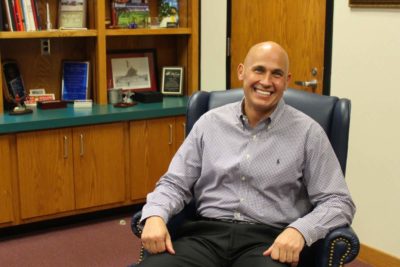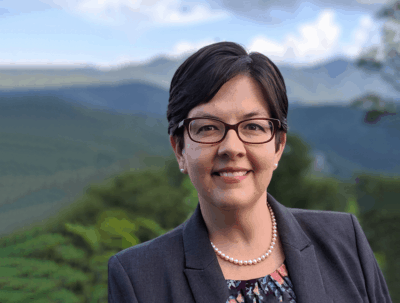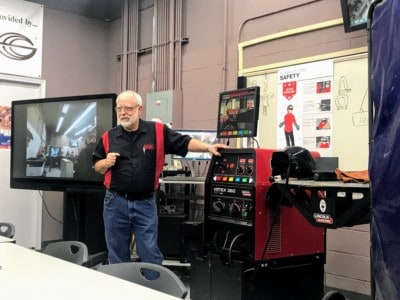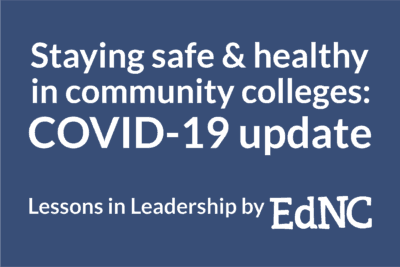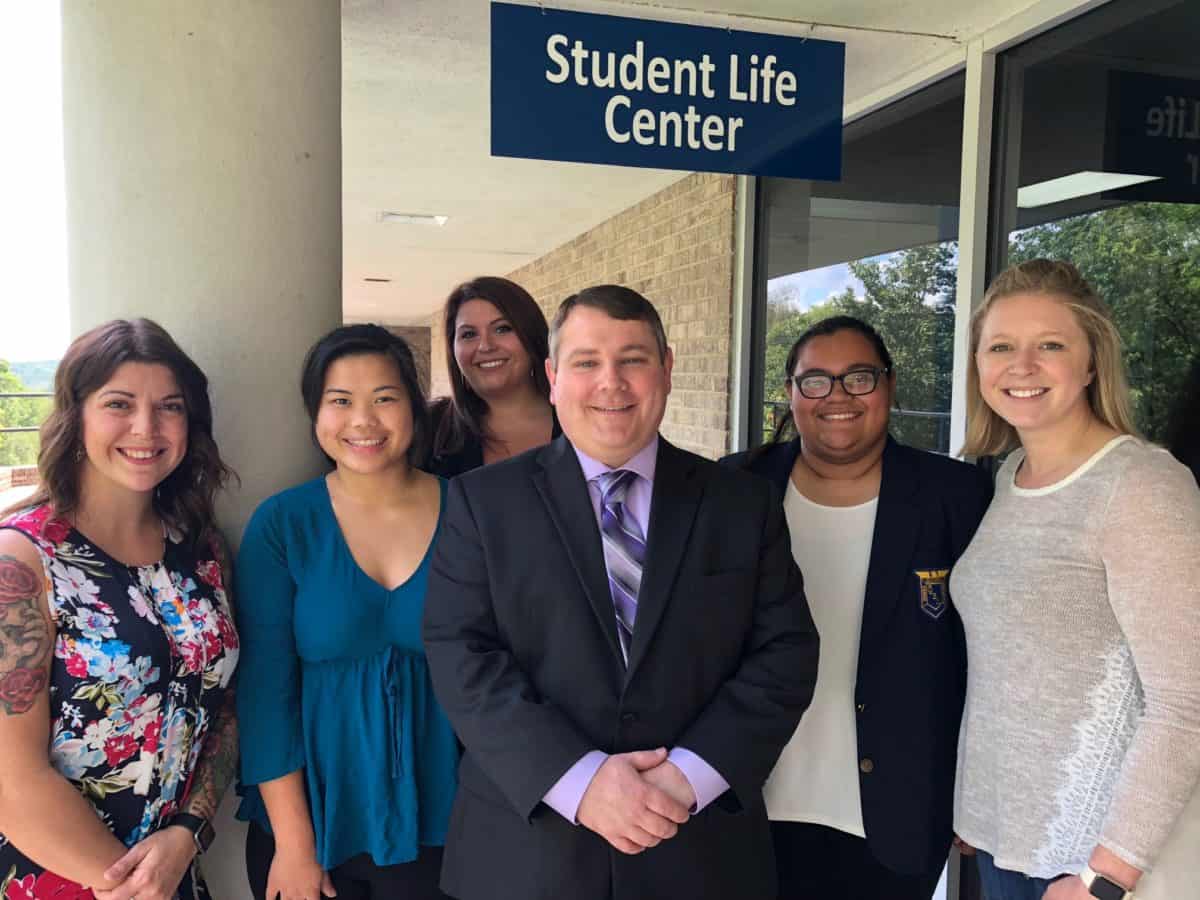

Meet Dr. John Enamait, the president of Stanly Community College in Albemarle.
The same day Enamait received his offer to be president, his mom passed away.
She would be proud of him. In Enamait’s story to become president of a community college, you see the determination he now sees in so many of his students.
He refers to what I see as determination as “a mindset of continuous improvement.”
Go ahead and guess now how many years it took Enamait to work his way from being a community college student to being a community college president.
In EdNC’s series on community college leaders, we are thinking about what it takes to be a great president. From education and work experience, to thought leadership and leadership development, from fundraising to serving students and the community, you can see it all in Enamait’s story.
Finding a pathway: Education and work experience
“My guidance counselors weren’t paying attention to me,” Enamait tells me as we start talking about his own journey to becoming a community college president.
He says his first degree, an associate in applied science from Caldwell Community College & Technical Institute in June 1997, “helped me get on my path better than anything else.”
It took him four years to get the two-year degree. He was working, making $12 an hour.
In May 1999, he graduated from Gardner-Webb University with a bachelor of science in business administration, and then in August 2001, he completed his masters in business administration with a concentration in international business at the same institution.
He worked his way through all of it. He was a project manager for Coldwater Creek. He was a manufacturing engineer for NAACO. When he was offered his first job as an instructor at a community college, it required him to take a 50% pay cut.
In December 2004, he obtained a graduate website developer certificate from East Carolina University.
And in May 2012, he completed his Ph.D. in technology management from Indiana State University, specializing in digital communications. The title of his dissertation is The Effect of Password Management Procedures on the Entropy of User Selected Passwords.
Enamait was the first in his family to go to college, but his wife and dad followed his lead.
On his path to the presidency, Enamait worked as an instructor at Caldwell Community College & Technical Institute for four years from 2003-2007. He then served as dean at Catawba Valley Community College for almost eight years from 2007-2014. And then he served as vice president of instruction at Edgecombe Community College for two years from 2014-2016.
His own journey taught him the importance of continuous improvement, a mindset that becomes important in his leadership for his students, for his teams, for the institutions he serves.
Monday, August 15, 2016, was Enamait’s first day on the job as president of Stanly Community College.
He serves 3,642 curriculum students and 6,067 non-curriculum students.
Thought leadership begins with empathy
Enamait understands what it is like to be a community college student. He was one.
He understands what it is like to be a community college instructor. He was one.
He understands what it is like to be a community college administrator. He was one.
And the capacity for leaders to really empathize should not be underestimated.
But leadership requires more. It requires community college presidents to begin to share what they know with community college trustees, county commissioners, philanthropists, policymakers, and the media.
Enamait writes about first-generation college students, about the difference between AP and dual enrollment, about financial aid. He celebrates holidays and graduations publicly with the community he serves.
He shows vulnerability, talking about the challenges he faces.
He shares lessons learned. When Stanly Community College got rid of Ds, its student transfer success rate increased 15%.
From school shootings to hurricanes, Enamait writes in Community College Daily about how presidents and community colleges should prepare for the worst.
It’s no surprise that Stanly Community College is leading in the COVID-19 pandemic, donating four ventilators to a local hospital.
Continuous improvement requires professional, leadership, and organizational development
The best leaders connect their own leadership to the leadership of the organization they serve and then to the leadership of society.
In 2016, Enamait participated in the Future Presidents Institute hosted by National Search & Education Consulting.
Enamait is the chair-elect of the Stanly County Chamber of Commerce, and he serves on the board of the Stanly County Economic Development Commission.
He is chair of the personnel and professional development committee for the N.C. Association of Community College Presidents, and he serves as vice-chair of the board of the Southern Association of Colleges with Associate Degrees (SACAD).
This year, in 2019-2020, Enamait was selected to be an Aspen Presidential Fellow “through a rigorous process that considered their abilities to take strategic risks, lead strong teams and cultivate partnerships, and focus on results-oriented improvements for greater student success and access,” according to the Aspen Institute’s website.
And he recently accepted a role on the Stanly County Family YMCA’s Board of Directors.
Enamait has continued and created opportunities for organizational development while president.
In 2015, before he became president, Stanly Community College became one of 30 institutions of higher education across the United States — and the only one in North Carolina — selected to participate in the American Association of Community Colleges (AACC) Pathways Project (see the new pathways resources website).
The three-year project is designed to build “capacity for community colleges to design and implement structured academic and career pathways at scale, for all of their students.”
In 2017, Stanly Community College was one of eight community colleges designated a “leader college” in the Achieving the Dream network, “awarded to institutions that have shown three years of steady improvement in student success outcomes like graduation and remedial education completion.”
In this video, Enamait and Audrey Jaeger, the executive director of the Belk Center for Community College Leadership and Research, talk about the strategic role of community colleges in North Carolina, with a focus on the urgency of the myFutureNC attainment goal and the need for a statewide leadership strategy.
Enamait believes, “Together, we can break barriers and lift dreams.”
Capacity to be a fundraiser
On Enamait’s CV, he lists the grants he has received during his tenure at community colleges across North Carolina. It reinforces the importance for community college presidents to be able to serve as fundraisers.
The grants Enamait has received have funded everything from mechatronic training programs to machining curriculum to simulation equipment to upgrades in safety and security for his campus.
Willingness to serve students and the community
“You never know what impact you are going to have on student lives,” said Enamait when I visited him back in September 2018 during EdNC’s blitz of all 58 community colleges. “That’s why I care so much about what we’re doing here.”
Because Stanly Community College is a small, rural college, the administrators, including Enamait, know the students and treat them like family. “My job is to remove obstacles and provide resources,” Enamait told me. The college has a food pantry and a student emergency fund.
At the student life center, Enamait and I visited with students.
It took Enamait 19 years to get this job.
“I love what I do,” he said.


